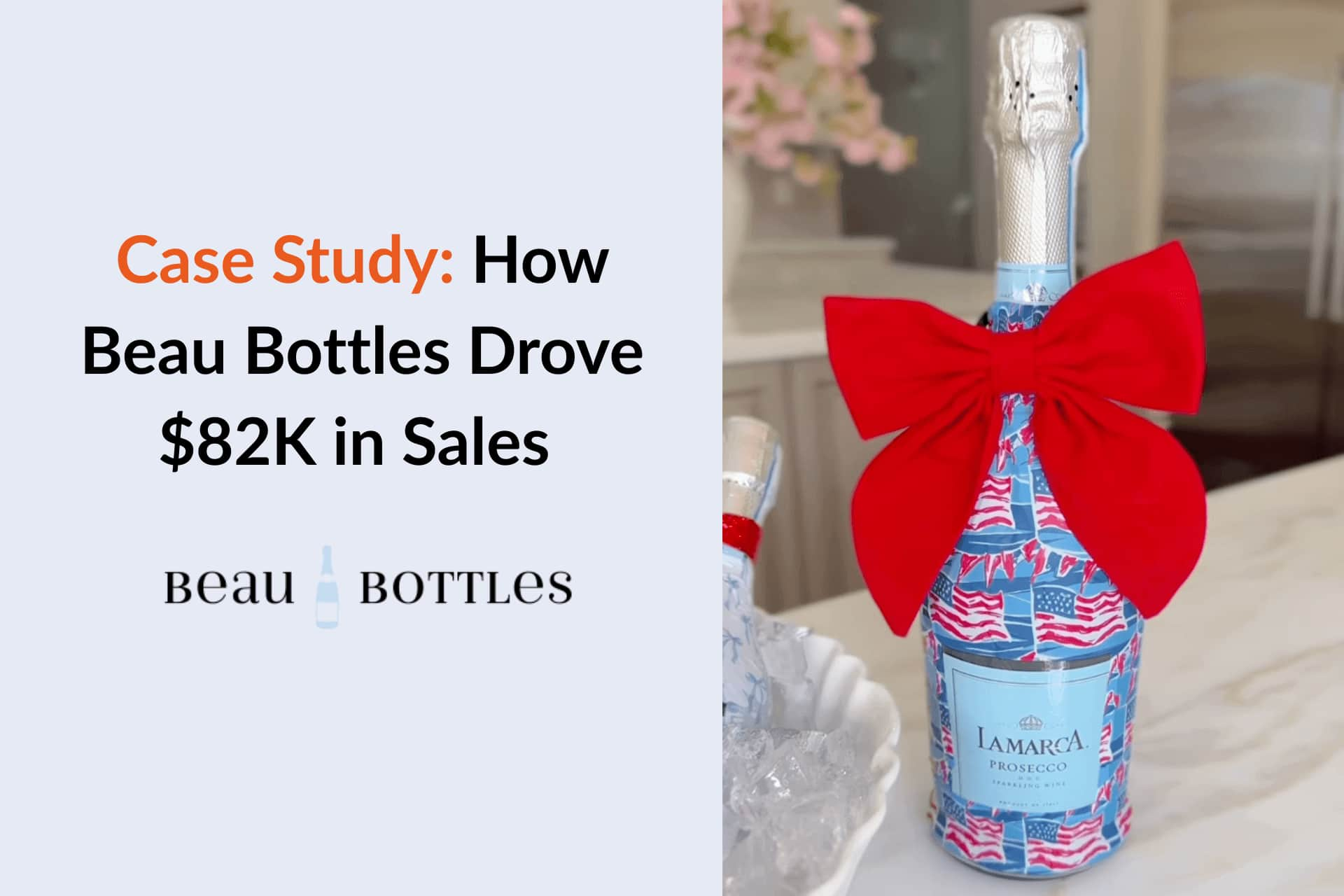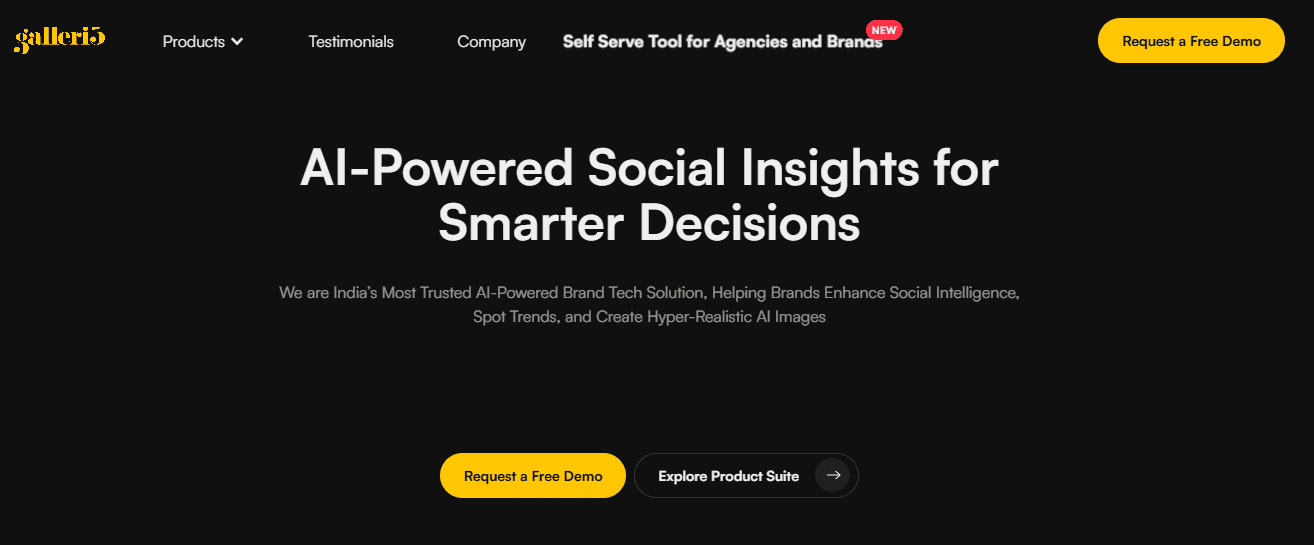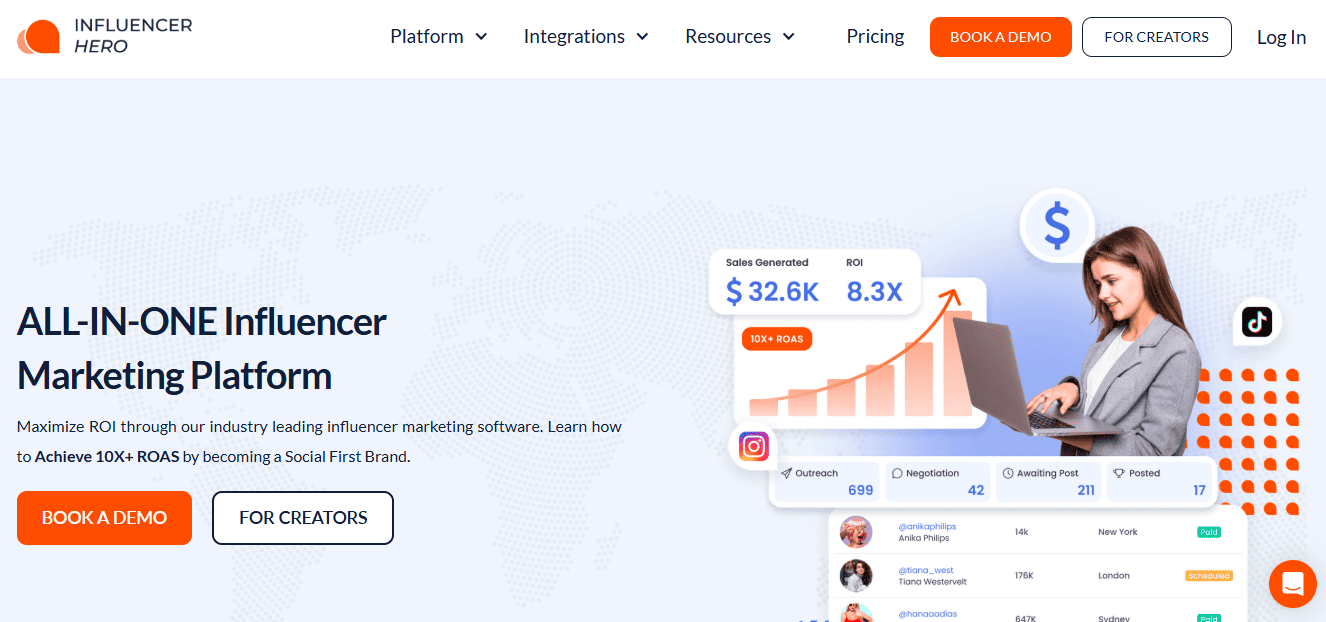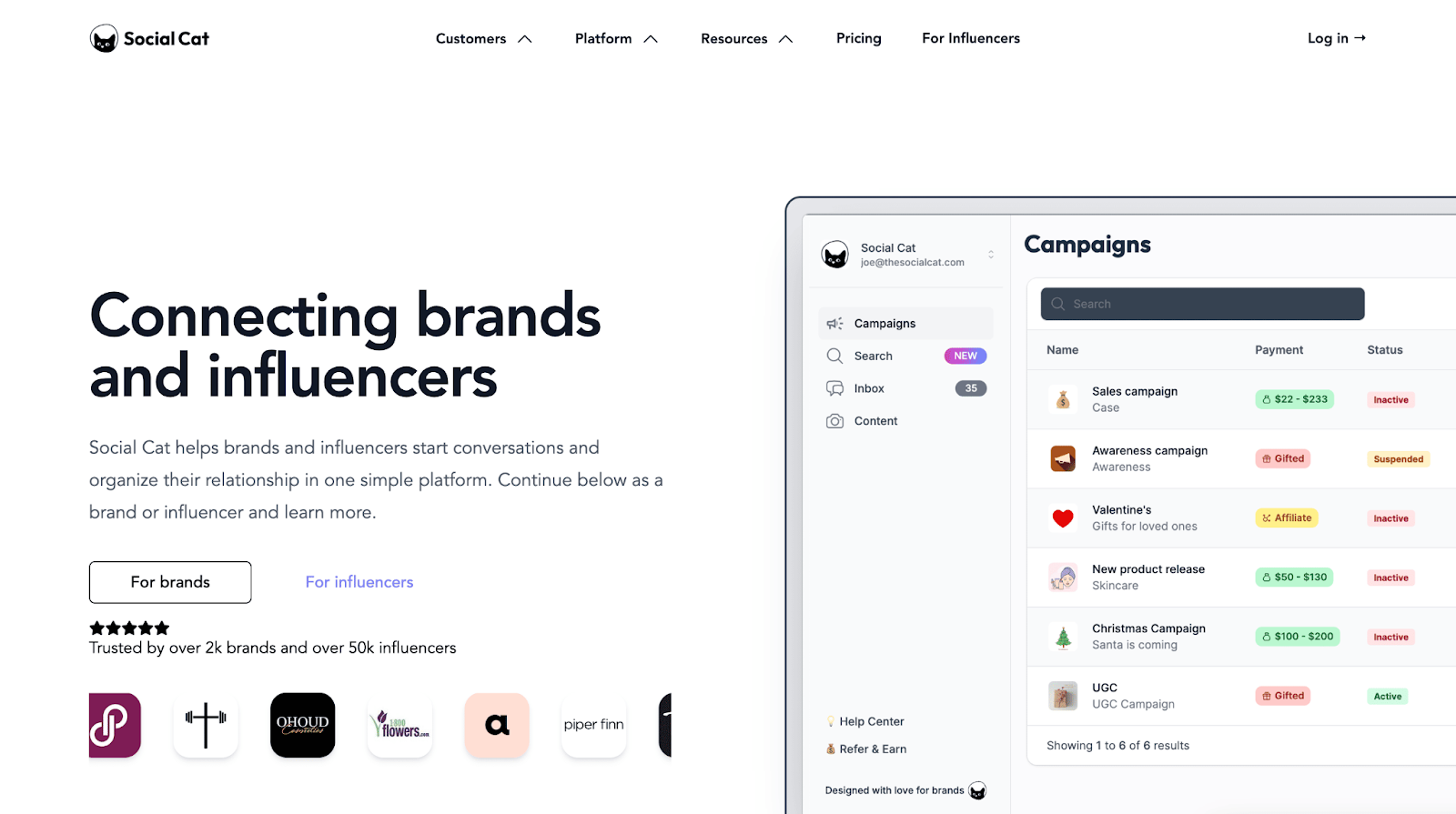





While Galleri5 remains a prominent AI-driven influencer marketing platform in India—especially following its acquisition by Collective Artists Network in 2024—there are notable drawbacks that prompt brands to look elsewhere. For example, its influencer pool is predominantly regional with limited global reach, content ideation tools receive mixed reviews, and pricing remains undisclosed, complicating budgeting for many organizations.
In this updated 2025 comparison we examine ten top alternatives in depth, highlighting features, pricing models, and user experiences to help you make an informed decision.
And here are the Top 10 alternatives we will explore in this article:
While Galleri5 offers AI-powered influencer marketing tools, several independent sources highlight limitations that may prompt businesses to explore alternatives.
Public buyer feedback skews heavily toward Asia on G2 (all listed reviews come from that region), making it harder for EMEA/AMER teams to assess market fit and support. In parallel, much of the public chatter referencing “Galleri5” online points to their AI demo/models rather than hands-on platform reviews, which thins out third-party validation outside India.
Verified reviewers recommend expanding the influencer pool and elevating content strategy/analytics involvement, suggesting that some brands may want deeper strategic and measurement capabilities than what’s reported today.
Multiple reviews describe briefing challenges (briefs not understood in one pass, requiring multiple creator lists) and unnecessary steps that increase turnaround time (TAT)—constraints that can slow fast-moving campaigns.
At least one reviewer notes a desire for the team to be more result-oriented on conversions, which can be a deciding factor for performance-driven programs.
Our comparison focuses on several key aspects:

Best For: Galleri5 is best suited for eCommerce and retail brands, particularly those in fashion, lifestyle, and consumer products, looking to combine influencer marketing with trend insights and AI-driven creative content.
Platform Coverage:
Pricing: Galleri5 does not list public pricing. Based on our research, the platform is offered via a monthly subscription across its Analytics, Marketing, and Commerce solutions, with a free trial available. Plans are sales-quoted, meaning businesses need to contact Galleri5 directly for a custom quote.
Reviews: 4.6 / 5.0 (G2)
Ease of Use (UX/UI): Users describe Galleri5 as relatively seamless to use, with workflows that reduce back-and-forth between brands and influencers. However, some reviews note occasional operational friction, such as multiple influencer lists being required or additional process steps slowing down execution.
Customer Support: Galleri5 is rated highly for Quality of Support on G2, with brands noting responsive assistance and managed workflows that smooth the campaign process. At the same time, some reviews suggest briefing misalignments can require extra clarifications.

Best For: Influencer Hero is best for growing D2C/eCommerce brands that want an all-in-one, automation-first stack to scale influencer discovery, outreach, CRM, content collection, and ROI tracking across multiple social platforms.
Platform Coverage:
Pricing: Influencer Hero offers flexible pricing plans to accommodate growing brands. All plans include core features and can scale as the influencer program grows.
Reviews: 5.0 / 5.0 (Capterra)
Ease of Use (UX/UI): Influencer Hero is known for a clean, intuitive interface with a streamlined dashboard and drag-and-drop campaign setup. Teams highlight automated workflows and customizable email templates (plus a Chrome extension) that save hours each week.
Customer Support: Support is a core strength: real-human live chat and responsive email, an in-platform Help Center with written and video tutorials, and a dedicated account manager from day one. Optional strategy consultations are available; Pro users can also access a private Slack channel for faster, ongoing support.
Galleri5 differentiates with Trends Intelligence and AI Images (synthetic models, virtual try-on, product placements) paired with creator/brand analytics. Influencer Hero centers on end-to-end execution—discovery → AI-personalized outreach → CRM → eCommerce gifting → affiliate/ROI analytics—to connect creator activity directly to revenue.
Galleri5 does not publish pricing and typically operates on sales-quoted plans (with a free-trial note on listings), which can hinder early budget planning. Influencer Hero publishes clear monthly tiers (from $649 to $2,490 with defined creator limits), making costs predictable as you scale.
If you prioritize transparent pricing, automation-driven workflows, and hands-on support, Influencer Hero is typically the stronger fit for day-to-day campaign operations.

Best For: Modash is best suited for eCommerce brands and startups that prioritize scale and precision in influencer discovery, especially those running affiliate or gifting campaigns via Shopify.
Platform Coverage:
Pricing: There are different plans and options.
Reviews: 4.7/5 (G2)
Ease of Use (UX/UI): Users describe Modash as intuitive, with a clean interface that makes it simple to filter and analyze influencers across Instagram, TikTok, and YouTube. The AI-powered discovery and lookalike tools reduce manual search time significantly. Some users note that while campaign workflows are straightforward, managing content licensing and paid ads requires manual work.
Customer Support: Modash has a reputation for strong onboarding and ongoing support. The team is responsive via email and dedicated account management, with clear walkthroughs for setup and scaling. While users praise the reliability of the help provided, they also note that documentation around advanced features like affiliate programs could be more extensive.
Galleri5 emphasizes AI-powered influencer matching and campaign management as a managed service, which is particularly valuable for brands that want more hands-on support and prefer not to manually negotiate contracts or manage tracking . In contrast, Modash is designed as a self-service SaaS tool, giving brands direct access to a massive creator database and powerful search filters.
Pricing also reflects this distinction. Galleri5 follows a quote-based model, often aligned with managed service offerings. Modash, however, offers transparent subscription tiers: Essentials at $199/month and Performance at $499/month, with enterprise options for larger brands. This makes Modash more appealing for data-driven teams that prefer control and predictable SaaS pricing, while Galleri5 is better for brands seeking a managed, concierge-style approach.

Best For: Enterprise brands running large, multi-platform influencer programs that need rigorous brand-safety controls, content approvals, and deep reporting—especially eCommerce teams on Shopify that want integrated gifting and affiliate code tracking.
Platform Coverage:
Pricing & Commitment: Pricing varies depending on every brand's needs.
Reviews: 4.5 / 5.0 (Capterra)
Ease of Use (UX/UI): Users highlight that the campaign workflow dashboard centralizes creator review → proposal → approval → posting, cutting down email back-and-forth. Built-in content approvals let creators submit drafts for review, and customizable dashboards plus exportable reports make stakeholder updates straightforward.
Customer Support: The demo materials don’t spell out support tiers, but Sprout Social targets enterprise teams on 12-month contracts—typically paired with structured onboarding and success management. Role-based seat permissions and easy report sharing also reduce ad-hoc support needs for day-to-day collaboration.
Galleri5 combines creator analytics and social/trend intelligence with an AI creative stack (synthetic models, clothing transfer, virtual try-on) and positions itself as an AI-powered brand tech suite. Pricing is opaque (“contact for pricing”), with a free trial indicated in third-party listings.
By contrast, Sprout Social is a classic enterprise influencer platform with workflow, approvals, competitive benchmarking, and explicit pricing at $1,599 per user/month on a 12-month contract (additional seats $600/month).
Choose Galleri5 if trend mining and AI content generation are key to your strategy (e.g., rapidly producing on-brand visuals and mining consumer/retail trends). Just validate creator supply in your target geos and nail down the sales-quoted plan. Choose Sprout Social if you need end-to-end enterprise governance—brand-safety gates, formal approvals, competitive reports, and Shopify-connected gifting/affiliate workflows—with transparent (though premium) pricing.

Best For: Upfluence is best for eCommerce brands (Shopify & Amazon sellers) that want an end-to-end stack for discovery, outreach, campaign execution, affiliate tracking, and payouts—while tying creator activity directly to revenue attribution. It’s a strong fit for teams converting existing customers into brand advocates and running scalable gifting/affiliate programs.
Platform Coverage:
Pricing:
Reviews: 4.5/5 (G2)
Ease of Use (UX/UI): The platform centralizes discovery, outreach, CRM, tracking, and : payments in one interface, reducing tool-switching during campaigns. Teams benefit from advanced search filters and a built-in social listening module for quicker research and shortlisting. New users should plan for some ramp-up: the breadth of features and ecommerce connections can feel complex at first.
Customer Support: The materials highlight deployment around Shopify/Amazon integrations and an emphasis on ROI tracking; while specific channels aren’t detailed, the end-to-end scope suggests guided setup and ongoing assistance are part of typical engagements. Note that contract structure is more enterprise-oriented (annual terms, no free trial), so prospective teams should clarify onboarding provisions and success resources during procurement.
Galleri5 combines creator analytics with Trends Intelligence (100M+ posts/50K+ articles) and an AI Images suite (synthetic models, virtual try-on, product placement) aimed at content creation and market insight. Upfluence, by contrast, is an eCommerce-centric execution platform built to connect creator activity to tracked sales.
Galleri5 follows a quote-based model (public price cards not listed). Upfluence lists $1,276/month on an annual term (billed monthly) with options like removing the Payments module (-$399) and no commission fees; annual contracts with quarterly options are available.
Choose Upfluence if your priority is eCommerce-grade measurement and converting customers into creators inside a single, campaign-ready system. Choose Galleri5 if you need deeper trend signals and AI image production alongside creator analytics, and you’re comfortable validating pricing and regional creator coverage during the sales process.

Best For: Enterprise and upper–mid-market brands that need large-scale creator discovery (15M+ profiles), collaborative campaign management, and rigorous performance tracking—with optional creator storefronts/affiliate commerce for conversion-led programs.
Platform Coverage:
Pricing: There are different pricing options:
Reviews: 4.1/5 (G2)
Ease of Use (UX/UI): Teams call out time-savers like reusable “locked” search filters, in-platform chat/approvals on each creator, and drag-and-drop metrics when building reports—so less duplicative work across campaigns. Public report links let non-license stakeholders view dashboards without logging in, which simplifies internal reviews.
Customer Support: User feedback outside the demo is mixed: some reports mention slow or unresponsive support and unresolved account/payment issues from both brand and creator sides. Given the enterprise focus and annual contracts, buyers often expect white-glove service—so diligence on SLAs and finance workflows is recommended.
Galleri5 positions itself as an AI-powered brand tech suite that fuses creator analytics and trend intelligence with an in-house AI creative stack (synthetic models, virtual try-on, clothing transfer). Pricing is sales-quoted with a free-trial note in third-party listings, so it’s less transparent.
Captiv8 is a classic enterprise IM platform with large-scale discovery, strong collaboration, and detailed reporting—priced at ~$25k annually (+$3k onboarding) and an optional $20–30k/month package for Storefronts + Affiliate.
Choose Galleri5 if you want trend mining plus rapid, on-brand asset generation to fuel campaigns—especially for fashion/retail workflows—and you’re comfortable engaging sales for scope and price. Choose Captiv8 if your priority is operational rigor at scale (discovery, approvals, reporting, competitive tracking) and you have the budget for enterprise pricing; just validate support quality and payment operations during procurement.

Best For: CreatorIQ is best for mid-market to enterprise brands that need a compliance-grade, end-to-end influencer platform—covering discovery, activation, campaign management, reporting, and built-in creator payments/tax handling—with reliable, real-time data via direct API integrations.
Platform Coverage:
Pricing: There are different plans:
Reviews: 4.7/5 (G2)
Ease of Use (UX/UI): Teams can build briefs, configure deliverables per creator, and share one-sheet approvals and live reports as public links (no login needed), which streamlines stakeholder reviews. The CRM workspace (tags, notes, history) plus templates and email aliases help keep operations in one place.
Customer Support: CreatorIQ provides a dedicated implementation manager and customer success team, with onboarding, strategy, and even quarterly planning support. The vendor also maintains deep partnerships with major social platforms, giving users early access to new features and ensuring data reliability.
Galleri5 blends creator/brand analytics with Trends Intelligence (signals from 100M+ social posts / 50K+ articles) and an AI Images studio (synthetic models, virtual try-on, product placement) aimed at content creation and market insight. CreatorIQ is a lifecycle execution platform that emphasizes data fidelity (direct APIs), approvals, custom reporting, and built-in payments/tax compliance—designed to run large, complex programs.
Galleri5 operates on quote-based pricing (no public price cards). CreatorIQ sells on annual contracts only, with guidance pointing to $2K–$5K/month for Basic/Standard tiers; creator payouts are free up to $100K/year, then 2% afterwards, and a branded Creator Connect portal is an optional $15K/year add-on. If you need predictable enterprise budgeting with formal payments and reporting,
Choose CreatorIQ when your priority is governance-grade data, approvals, custom analytics, and finance workflows at scale. Choose Galleri5 if your team wants trend foresight plus AI-generated creative alongside creator analytics, and you’re comfortable with a sales-quoted model and validating regional creator coverage during evaluation.

Best For: Performance-minded brands and agencies that need rigorous influencer discovery across Instagram, TikTok, YouTube, Twitch, X, and Snapchat—plus built-in outreach, contracts/e-signature, and eCommerce tracking (Shopify + PayPal) to prove revenue and conversion per creator.
Platform Coverage:
Pricing: HypeAuditor’s pricing is customizable, with the standard “Business” plan starting at around $10,000/year. Pricing can be adjusted based on the number of reports, active campaigns, and platform usage. They also offer a 24–48 hour free trial for new users.
Reviews: 4.6/5 (G2)
Ease of Use (UX/UI): Teams can spin up targeted searches quickly with AI-powered category detection, lookalikes, and social listening—then save creators to lists and bulk-message with templates. Campaign workstreams are organized with creator “cards” that centralize briefs, drafts, and approvals, and final reports are shareable via link or PDF for easy stakeholder review.
Customer Support: The materials indicate onboarding and support are included with Business-tier deployments, and pricing can be tailored to usage (e.g., reports, active campaigns). Given the modular setup and enterprise options, it’s smart to confirm SLAs and finance workflows during procurement.
Galleri5 is an AI-powered brand tech suite that blends creator analytics and trend intelligence with an in-house AI creative stack (synthetic models, clothing transfer, virtual try-on) to generate on-brand visuals without new shoots. Public pricing is opaque (“contact for pricing”), with a free trial noted in third-party listings; diligence on geography/creator coverage is recommended.
HypeAuditor, by contrast, is a classic influencer marketing platform centered on large-scale discovery, outreach/CRM, and end-to-end performance measurement—including Shopify/PayPal integrations to track revenue and conversion per creator. Pricing is more transparent: a customizable structure with a Business plan around $10k/year and a 24–48h free trial to de-risk evaluation.
Choose Galleri5 if your priority is trend mining plus rapid, on-brand content generation (e.g., fashion/retail creative at scale) and you’re comfortable engaging sales for a tailored plan. Choose HypeAuditor if you need robust cross-platform discovery, built-in outreach and contracting, and commerce-grade ROI tracking—especially if you want clearer baseline pricing to forecast budget.

Best For: GRIN is best for DTC/eCommerce brands that want to run end-to-end influencer programs—from discovery and outreach to product seeding, in-app payments, UGC collection, and ROI tracking—in a single platform built around Shopify, WooCommerce, Magento and PayPal.
Platform Coverage:
Pricing:
Reviews: 4.5 / 5.0 (G2)
Ease of Use (UX/UI): Teams like GRIN’s all-in-one workflow, which reduces tool-switching and keeps creator comms and tasks centralized. The UGC library (including Instagram Stories) and email syncing help keep deliverables and conversations tidy. Some users flag performance hiccups (slow loads, buggy uploads/integrations) that can interrupt otherwise smooth day-to-day work.
Customer Support: Customers highlight helpful onboarding and program strategist options when needed, plus practical guidance around gifting and payouts. That said, there are reports of uneven follow-through (delays or unresolved tickets) for certain issues—worth clarifying SLAs and escalation paths during procurement.
Focus & workflow: Galleri5 blends creator analytics with Trends Intelligence (signals from 100M+ posts / 50K+ articles) and an AI Images studio (synthetic models, virtual try-on, product placement) to guide content and category decisions. GRIN is an eCommerce-first execution platform that emphasizes product seeding/gifting, commissions, in-app payouts, and UGC rights—built to connect creator activity to transactions.
Pricing & contracts: Galleri5 runs on sales-quoted pricing (no public price cards). GRIN typically requires an annual commitment, with materials citing a $25,000/year starting price and other guidance of $2.5k–$10k+/month depending on scope. If you need transparent eCommerce workflows and embedded finance/rights ops, GRIN offers clear, operational levers (but at an enterprise price). If your priority is trend mining + AI creative generation alongside analytics, Galleri5’s model can be compelling—provided you validate regional creator coverage and secure a quote that fits your budget.
When to choose which: Pick GRIN if success = tracked sales, scalable seeding, and integrated payouts/rights across large catalogs. Pick Galleri5 if you value market trend signals and synthetic creative to fuel campaigns, and you’re comfortable with a bespoke pricing process and confirming fit for your geography.

Best For: SMBs and emerging DTC brands that want an affordable, lightweight stack for influencer discovery, AI-assisted outreach, and a built-in CRM—without enterprise lock-ins or long contracts. Wednesday.App suits teams starting or scaling lean programs that still need real reporting and simple gifting/affiliate workflows.
Platform Coverage:
Pricing:
Reviews: 4.6/5.0 (G2)
Ease of Use (UX/UI): Wednesday is intentionally “all-in-one lite,” keeping discovery, outreach, and CRM in a clean, browser-based workspace with no bloat. Saved lists/tags, brief/contract templates, and a native inbox reduce tab-hopping, while AI helps with both matching and message drafting so teams move faster with fewer manual steps.
Customer Support: Support level isn’t heavily marketed in the summary, but the product is designed for self-serve SMBs (free forever tier, $1 trial, cancel anytime). In practice that usually means lightweight assistance plus product guidance; if you need SLAs or multi-user onboarding, confirm details when choosing.
Galleri5 is an AI-powered brand tech suite that fuses creator analytics and trend intelligence with an in-house AI creative stack for rapid asset production—strong for fashion/retail and teams that want trend mining plus AI image generation. Wednesday.App is a streamlined discovery-to-CRM tool aimed at SMBs that need practical outreach, messaging, and campaign tracking without heavyweight integrations.
Galleri5 pricing is sales-quoted and not publicly listed (third-party listings mention a free trial), so expect a discovery process to size modules and usage. Wednesday.App is transparent and low-friction: Free forever Starter, $79/month Discovery for unlimited search/profiles/messaging, and an Outreach tier at $279/month (waitlist) with mass email and advanced CRM—no annual lock-in.
Pick Galleri5 if your priority is trend-driven planning and on-brand image generation alongside creator analytics—especially in categories like fashion/retail—and you’re comfortable engaging sales for scope/price. Choose Wednesday.App if you want to start or scale a lean, performance-minded influencer program with AI-assisted discovery/outreach and a simple CRM at SMB-friendly pricing. Validate geography/creator coverage for Galleri5, and confirm Wednesday’s Outreach waitlist timing if mass email is a must-have.

Best For: Social Cat is best for small to medium-sized brands that want a simple, budget-friendly way to run UGC and product seeding collaborations—without the complexity or cost of enterprise suites. It’s especially strong if your focus is Instagram/TikTok micro- and nano-creators via an application-based workflow.
Platform Coverage:
Pricing:
Reviews: 4.3/5.0 (Trustpilot)
Ease of Use (UX/UI): The interface is intentionally beginner-friendly, with a guided Campaign Builder that lets brands publish collaboration briefs and review incoming creator applications in one place. Built-in in-app messaging and a basic CRM (threads, contracts) keep communication organized.
Customer Support: All plans include email support, with priority support on the Pro tier. Since the product is designed for smaller teams, the support model emphasizes clarity in campaign setup, contracts, and content rights rather than heavy, enterprise-style implementation.
Social Cat Standout Features:
Galleri5 targets a data/creative intelligence use case—creator analytics, Trends Intelligence, and an AI Images studio for synthetic models and product placements. Social Cat is a lightweight collaboration hub for SMBs focused on campaign applications, product seeding, in-app messaging, and built-in usage rights—with minimal complexity.
Galleri5 operates on sales-quoted pricing (no public price cards). Social Cat lists transparent monthly tiers at $99 / $199 / $299, with clear limits on creators/month, invites, campaigns, and team seats—easy to forecast for smaller budgets.
Pick Galleri5 if your priority is market trend mining and AI-generated creative paired with analytics, and you’re comfortable with bespoke pricing and validating regional creator coverage. Choose Social Cat if you want a starter-friendly, low-cost way to source IG/TikTok creators, run seeding/UGC collaborations, and reuse content with included rights—without enterprise overhead.
When it comes to choosing the right influencer marketing platform, the best fit depends on your brand’s goals, budget, and campaign needs. While Galleri5 has made its mark in India, the market is full of powerful alternatives offering broader features, global reach, and stronger analytics—from platforms like Sprout Social and Grin to HypeAuditor and CreatorIQ. These tools not only streamline influencer discovery and campaign management but also provide the integrations and reporting needed to maximize ROI.
Among all the options, Influencer Hero stands out as one of the top Galleri5 alternatives, combining advanced search filters, end-to-end campaign automation, and seamless CRM capabilities to help brands scale influencer partnerships effectively. Ready to see how it can work for your business? Book a free demo with Influencer Hero today and take your influencer marketing to the next level!

When evaluating Galleri5 or its alternatives, it’s important to look at influencer discovery tools, campaign management features, reporting/analytics, and pricing models. Also consider whether you prefer a managed service (like Galleri5) or an all-in-one SaaS platform (like Influencer Hero) that allows you to run everything in-house.
Yes. Many modern influencer platforms, including Influencer Hero, provide direct integrations with Shopify, WooCommerce, and Amazon, allowing brands to track affiliate sales, conversions, and ROI seamlessly. Galleri5 doesn’t natively support these integrations, which is why some eCommerce brands lean toward alternatives.
AI is becoming a key differentiator. Platforms like HypeAuditor and Influencer Hero use AI to help brands detect fake followers, predict campaign ROI, and automate influencer outreach. If scalability and fraud detection are important, choosing an AI-powered alternative might be more valuable than Galleri5’s managed approach.
Pricing varies widely:
Most Galleri5 alternatives provide built-in tools for contracts, payment automation, and UGC rights management. For example, Influencer Hero offers automated affiliate tracking and flexible payment options (direct pay, gifting, affiliate revenue share). Galleri5, by contrast, requires manual handling of contracts and rights, which may be slower for brands running high-volume campaigns.



Schedule a Demo with one of our media experts below.